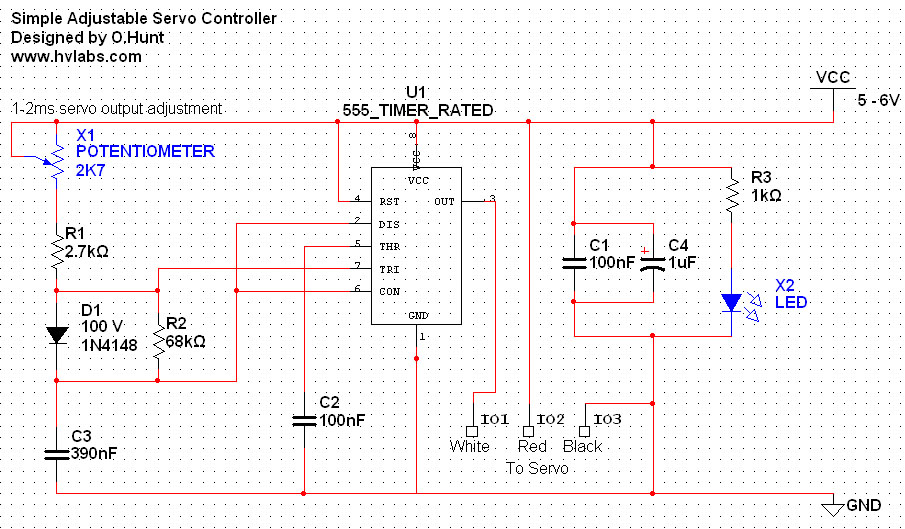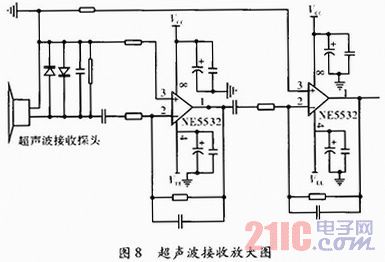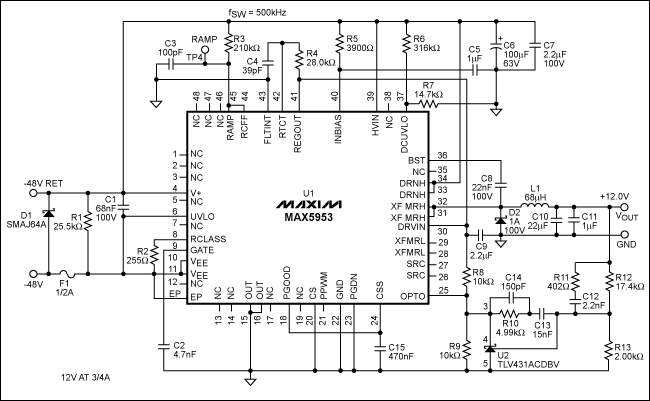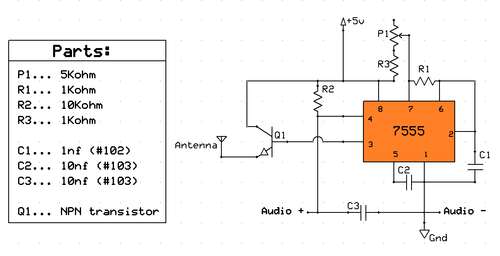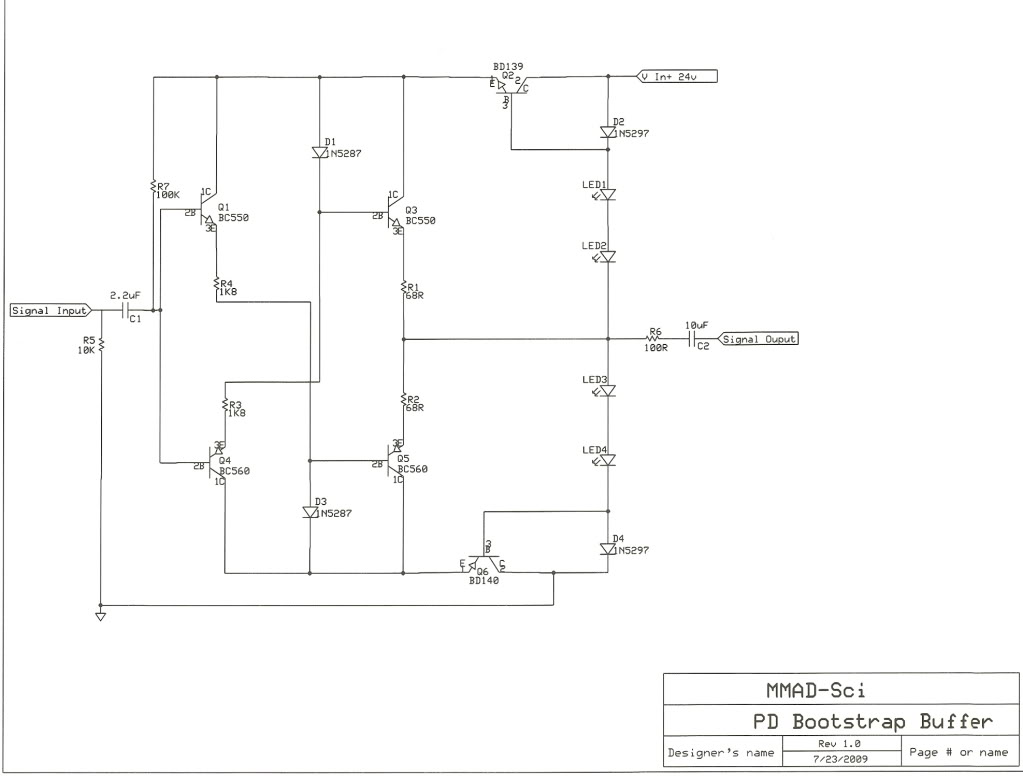
Extensible Multiple Device Programmer 4 Base
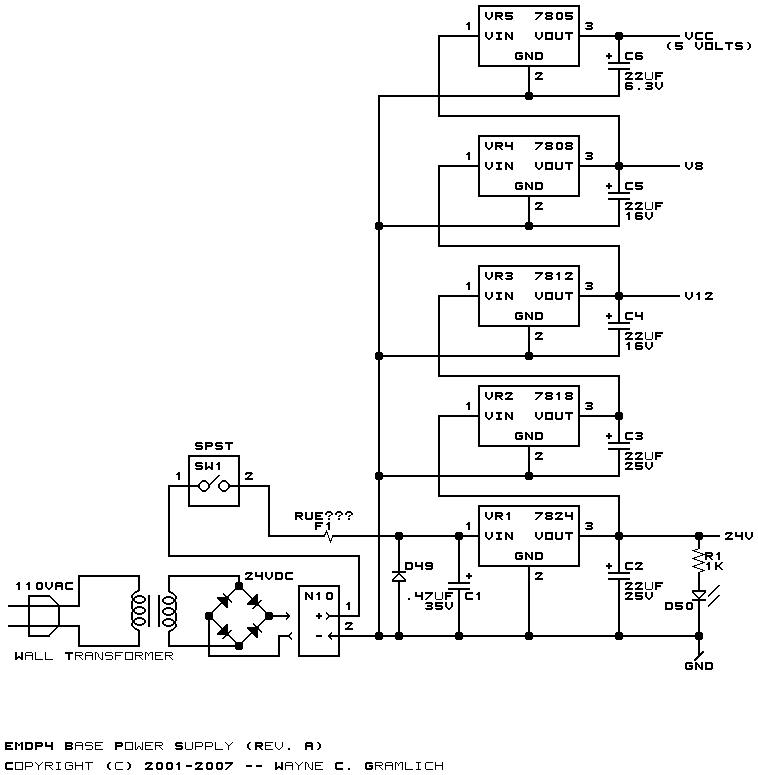
The 5-volt microcontroller interfaces with the RS-232 serial connector and the USB-B connector. It is responsible for communicating with the checker, controlling the status LEDs, and setting the voltage for the low-voltage microcontroller. The low-voltage microcontroller operates at the voltage level suitable for programming the device. It has direct control over a 24V DAC and an 8V DAC. The customization plug consists of numerous female pins for routing power and signals to the 40-pin ZIF socket, with one half connected to the low-voltage microcontroller. The power supply utilizes an Underwriters Laboratory® approved "wall wart" to provide 24V DC, ensuring that the baseboard does not have any 110V AC or similar voltages present. Power can be supplied through either N1 (onboard) or N3 (offboard). The power switch can be located onboard at SW1 or offboard as SW2 via connector N2. A resettable polyswitch fuse is implemented to manage short circuits at F1. D1 functions as a shorting diode that activates F1 if a VAC power source is mistakenly connected to N1 or N3. The remainder of the power supply consists of a series of linear voltage regulators (VR1-VR5) that step down the voltage from 24V to 18V, to 12V, to 8V, and finally to 5V. These supplies are utilized throughout the board, except for the 18V output, which is used to prevent excessive heat dissipation in the 24V regulator (VR1). Tantalum capacitors are employed due to their low series resistance. Although this design may not be energy-efficient, the EMPD3 is expected to remain off for 99% of its operational time, minimizing concerns. A green LED (D2) illuminates to indicate that the device is powered on. The EMDP4 board employs standard serial communication protocols. Connector N6 connects to a DB9 port on a host computer that operates using RS-232 voltage levels for signaling. U7, along with capacitors C7 through C10, converts RS-232 levels to 5V levels. Connector N7 features an RJ45 jack providing RS-422 using SimpliciNet pinouts. The DS8921AT (U10) facilitates RS-422 to 5V signaling level conversions. U9A ORs the received signals from U7 or U10 and forwards them to the slave microcontroller (U1), the master microcontroller (U2), and some gating circuitry that may route the signal to one of the bi-directional bus lines. U9B ORs the transmit signals from the slave microcontroller (U1), the master microcontroller (U2), and, through gating logic with U8, potentially one of the bi-directional buses; the ORed signal is sent to both the RS-422 connector and the RS-232 connector. U1, the back processor, is a low-voltage PIC16LF877 microcontroller that has direct access to all 30 bidirectional lines. The remaining two lines are LVPRX for serial data reception and LVPTX for serial data transmission. The adaptor boards can connect to the bus via a 37-pin female D connector (N4). Upon startup, the coprocessor takes control, asserting LVPRESET# to reset the low-voltage processor. Eventually, it sets VIO to the appropriate voltage and releases LVPRESET#. The low-voltage processor then initializes itself and places the bus lines in high impedance. The programming algorithm is downloaded over the serial lines LPVRX and LVPTX. The STB signal is located on RA5 of microcontroller U1, featuring an open collector output that requires a pull-up resistor (R21). Data from the IDDAT line is pulled high by R22 to detect the presence of an adaptor or plug connected to the system. The digital-to-analog converter is implemented by U15, a serial quad 8-bit D/A, with all reference voltages connected to 2.5 volts. D/A output A generates VAR1, providing a range of 0 to 24 volts in 0.1-volt increments, while D/A output B generates a 0 to 10-volt output.
The circuit design integrates various components to achieve the intended functionality. The microcontroller serves as the central processing unit, managing communication and control tasks. The RS-232 and RS-422 interfaces facilitate connectivity with external devices, enabling data transfer and device programming. The use of voltage regulators ensures that the microcontroller and associated components receive stable power, crucial for reliable operation. The resettable polyswitch fuse enhances safety by preventing damage from short circuits, while the shorting diode provides an additional layer of protection against incorrect voltage connections. The design's emphasis on using tantalum capacitors reflects a focus on performance, particularly in minimizing power loss and maintaining signal integrity. The dual DAC outputs allow for versatile analog signal generation, catering to various application needs. Overall, the schematic represents a well-thought-out integration of components that supports both functionality and safety in electronic device operation.The 5 volt microcontroller interfaces to the RS-232 serial connector and the USB-B connector. It is also responsible for talking to the checker, controlling the status LED`s and setting the voltage for the LOW voltaage microcontroller. The low voltage microcontroller is run at the voltage level appropriate for programming the device to be programm
ed. It has direct control over a 24V DAC and a 8V DAC. The customization plug is just a large number of female pins for routing power and signals to the 40-pin ZIF socket. One half of the customization plug is hooked to the low voltage microcontroller. The power supply uses a Underwriters Labratory ® approved "wall wart" to provide 24VDC of power. This means that the base board does not have any 110 AC or such voltages running around on it. The power comes in on either N1 (on board) or N3 (off board). The power switch can either be on board at SW1 or off board as SW2 through connector N2. A resettable polyswitch fuse is used to deal with short circuits at F1. D1 is a shorting diode that should trigger F1 if somehow a VAC power source gets plugged into N1 or N3.
The rest of the power supply a series of inexpensive linear voltage regulators, VR1-VR5, that step the voltage from 24 volts, to 18 volts, to 12 volts, to 8 volts and finally to 5 volts. All of these supplies are used elsewhere on the board except the 18 volt one, which is used to keep the 24 volt regulator, VR1, from disapating too much heat.
The capacitors are tantalum for their low series resistance. This design will not win any energy conservation awards, but since the EMPD3 should spend 99% of its time turned off, there should be no real complaints. Finally, green LED D2 lights up to indicate that the device is turned on. The EMDP4 is a board that uses standard serial communcations protocols. Connector N6 is used connect to a DB9 port on a host computer that uses RS-232 voltage levels for signalling.
U7 in conjunction with C7 through C10 converts the RS-232 levels to 5 volt levels. Connector N7 uses a RJ45 jack to provide RS-422 using SimpliciNet pin outs. The nifty DS8921AT at U10 provides RS-422 to 5 volt signalling level conversions. U9A OR`s the recevied signal from U7 or U10 and forwards the signal to the slave microcontroller (U1), the master microcontroller (U2), and to some gating circuitry that potentially gates the signal onto one of the bi-directional bus lines. U9B OR`s the transmit signals from the slave microcontroller (U1), the master microcontroller (U2), and through some gating logic with U8, potentially one of the bi-directional bus; the OR`d signal is forwarded to both the RS-422 connector and RS-232 connector.
U1 is the back processor is a low-voltage PIC16LF877. This microcontroller has direct access to all 30 of the bidirectional lines. The remaining two lines are LVPRX for serial data recieve, LVPTX for serial data transmit. The adaptor boards can be connected to the bus via the 37-pin female D connector N4. Upon startup, the coprocessor is in charge. It immediately asserts LVPRESET# to force the low voltage processor into the reset state. Eventually, it will get around to setting VIO to the correct voltage and will release LVPRESET#. After that, the low voltage processor initializes itself and forces the bus lines to high impedance. Next, the programming algorithm is downloaded over the serial lines LPVRX and LVPTX. Lastly, the STB signal is on RA5 of microcontroller U1. This pin has an open collector output an needs to be pulled high by R21. The data coming back from the IDDAT line is pulled high by R22 to detect when there is now adaptor/plug connected to the system. The digital to analog converter is implemented by U15, a serial quad 8-bit D/A. All of the reference voltages are tied to 2. 5 volts. D/A output A is used to generate VAR1, a 0 to 24 output in. 1 volt increments. D/A output B is used to generate a 0 to 10 volt output in. 🔗 External reference
The circuit design integrates various components to achieve the intended functionality. The microcontroller serves as the central processing unit, managing communication and control tasks. The RS-232 and RS-422 interfaces facilitate connectivity with external devices, enabling data transfer and device programming. The use of voltage regulators ensures that the microcontroller and associated components receive stable power, crucial for reliable operation. The resettable polyswitch fuse enhances safety by preventing damage from short circuits, while the shorting diode provides an additional layer of protection against incorrect voltage connections. The design's emphasis on using tantalum capacitors reflects a focus on performance, particularly in minimizing power loss and maintaining signal integrity. The dual DAC outputs allow for versatile analog signal generation, catering to various application needs. Overall, the schematic represents a well-thought-out integration of components that supports both functionality and safety in electronic device operation.The 5 volt microcontroller interfaces to the RS-232 serial connector and the USB-B connector. It is also responsible for talking to the checker, controlling the status LED`s and setting the voltage for the LOW voltaage microcontroller. The low voltage microcontroller is run at the voltage level appropriate for programming the device to be programm
ed. It has direct control over a 24V DAC and a 8V DAC. The customization plug is just a large number of female pins for routing power and signals to the 40-pin ZIF socket. One half of the customization plug is hooked to the low voltage microcontroller. The power supply uses a Underwriters Labratory ® approved "wall wart" to provide 24VDC of power. This means that the base board does not have any 110 AC or such voltages running around on it. The power comes in on either N1 (on board) or N3 (off board). The power switch can either be on board at SW1 or off board as SW2 through connector N2. A resettable polyswitch fuse is used to deal with short circuits at F1. D1 is a shorting diode that should trigger F1 if somehow a VAC power source gets plugged into N1 or N3.
The rest of the power supply a series of inexpensive linear voltage regulators, VR1-VR5, that step the voltage from 24 volts, to 18 volts, to 12 volts, to 8 volts and finally to 5 volts. All of these supplies are used elsewhere on the board except the 18 volt one, which is used to keep the 24 volt regulator, VR1, from disapating too much heat.
The capacitors are tantalum for their low series resistance. This design will not win any energy conservation awards, but since the EMPD3 should spend 99% of its time turned off, there should be no real complaints. Finally, green LED D2 lights up to indicate that the device is turned on. The EMDP4 is a board that uses standard serial communcations protocols. Connector N6 is used connect to a DB9 port on a host computer that uses RS-232 voltage levels for signalling.
U7 in conjunction with C7 through C10 converts the RS-232 levels to 5 volt levels. Connector N7 uses a RJ45 jack to provide RS-422 using SimpliciNet pin outs. The nifty DS8921AT at U10 provides RS-422 to 5 volt signalling level conversions. U9A OR`s the recevied signal from U7 or U10 and forwards the signal to the slave microcontroller (U1), the master microcontroller (U2), and to some gating circuitry that potentially gates the signal onto one of the bi-directional bus lines. U9B OR`s the transmit signals from the slave microcontroller (U1), the master microcontroller (U2), and through some gating logic with U8, potentially one of the bi-directional bus; the OR`d signal is forwarded to both the RS-422 connector and RS-232 connector.
U1 is the back processor is a low-voltage PIC16LF877. This microcontroller has direct access to all 30 of the bidirectional lines. The remaining two lines are LVPRX for serial data recieve, LVPTX for serial data transmit. The adaptor boards can be connected to the bus via the 37-pin female D connector N4. Upon startup, the coprocessor is in charge. It immediately asserts LVPRESET# to force the low voltage processor into the reset state. Eventually, it will get around to setting VIO to the correct voltage and will release LVPRESET#. After that, the low voltage processor initializes itself and forces the bus lines to high impedance. Next, the programming algorithm is downloaded over the serial lines LPVRX and LVPTX. Lastly, the STB signal is on RA5 of microcontroller U1. This pin has an open collector output an needs to be pulled high by R21. The data coming back from the IDDAT line is pulled high by R22 to detect when there is now adaptor/plug connected to the system. The digital to analog converter is implemented by U15, a serial quad 8-bit D/A. All of the reference voltages are tied to 2. 5 volts. D/A output A is used to generate VAR1, a 0 to 24 output in. 1 volt increments. D/A output B is used to generate a 0 to 10 volt output in. 🔗 External reference
